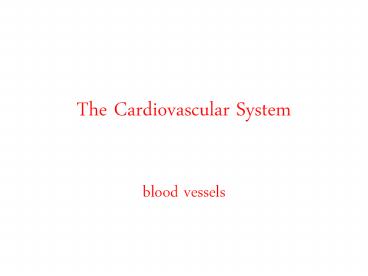The Cardiovascular System - PowerPoint PPT Presentation
1 / 39
Title:
The Cardiovascular System
Description:
The Cardiovascular System blood vessels Blood Circulation Blood is carried in a closed system of vessels that begins and ends at the heart Human Cardiovascular System ... – PowerPoint PPT presentation
Number of Views:65
Avg rating:3.0/5.0
Title: The Cardiovascular System
1
The Cardiovascular System
- blood vessels
2
Blood Circulation
- Blood is carried in a closed system of vessels
that begins and ends at the heart
3
Human Cardiovascular System
4
(No Transcript)
5
The 3 major types of vessels
- Arteries carry blood away from the heart
- Veins carry blood toward the heart
- Capillaries contact tissue cells (Serving
cellular needs)
6
Capillaries
Very narrow (10 µm diameter, the red blood
cells that travel through capillaries are 6 µm in
diameter). Capillaries are made of thin
endothelial cells (one layer thick)
7
(No Transcript)
8
Capillary Blood Flow
- Blood flow across the capillary bed is regulated
by a sphincter muscle on the arteriole side.
Whenever there is little need to supply blood to
a given capillary bed, the sphincter closes and
blood bypasses the capillary bed via an
arterio-venal shunt. - On the arterial side of the capillaries, blood is
under high pressure, whereas the blood at the
venal side is under low pressure.
9
(No Transcript)
10
Hydrostatic Osmotic Pressures
- The high hydrostatic pressure on the arterial
side squeezes water and nutrients out of the
capillaries. - Water leaving the capillaries builds up the
osmotic pressure because the blood components
have become more concentrated. - Towards the venal end, water and waste materials
are sucked into capillaries by the osmotic
pressure.
11
(No Transcript)
12
(No Transcript)
13
(No Transcript)
14
(No Transcript)
15
Capillary Dynamics
16
Capillary Exchange
- Gases, nutrients, and wastes are exchanged
between blood in the capillaries of tissues in 3
ways - 1. Diffusion
- a. most common
- b. substances including O2, CO2, glucose,
hormones - c. lipid-soluble substances pass directly
through endothelial cell membrane - d. water-soluble substances must pass
through fenestrations or gaps between endothelial
cells. - 2. Vesicular transport (endo/exocytosis)
- 3. Bulk flow (filtration and absorption).
17
(No Transcript)
18
Arteries arterioles
- (High pressure Low resistance)
- The blood vessels before the capillary beds
have to bear high hydrostatic pressures created
by the heart - Arteries and smaller arterioles are thick
walled tubes made of smooth muscle (to resist
high pressure), containing a layer of collagen
fibers (to give elasticity), and lined with
endothelial cells (to protect red blood cells
from mechanical damage).
19
Tunicas
20
Tunicas
21
(No Transcript)
22
(No Transcript)
23
(No Transcript)
24
Veins venules
- (Low Pressure Low Resistance)
- Contain valves to prevent the backflow of blood
- Varicose veins result due to a failure of these
valves
25
Venous Blood Flow
26
HEMODYNAMICS THE PHYSIOLOGY OF CIRCULATION
- Blood pressure pressure exerted by
blood on the wall of blood vessels. - In clinical use, we most commonly refer to mean
(systemic) arterial blood pressure (MABP),
because the blood pressure in the veins is
essentially insignificant. - The mean arterial blood pressure (MABP) rises to
its maximum during systole (contraction) and
falls to its lowest during diastole (relaxation). - In a normal adult at rest, the MABP 120 mmHg/80
mmHg
27
Factors that Influence Arterial Blood Pressure
- Heart Action (cardiac output)
- Blood Volume (increase in blood volume increases
BP) - Peripheral Resistance (resistance R opposition
to blood flow usually due to friction) - So we can say CO MABP/R
28
Blood Flow Friction
- This friction depends on 3 things
- 1. Blood viscosity
- 2. Total blood vessel length
- 3. Blood Vessel Radius
29
(No Transcript)
30
Regulation of BPBlood Flow
- F ?P/ R
- ?P change in pressure between arterial venous
ends - R Peripheral Resistance
31
Hormonal Control
- Several hormones affect BP by
- acting on the heart
- altering blood vessel diameter
- adjusting blood volume.
32
Hormones that increase BP
- Epinephrine and norepinephrine
- Increases CO (rate force of contraction)
causes vasoconstriction of arterioles. - Antidiuretic hormone (ADH)
- Causes vasoconstriction of arterioles during
diuresis and during hemorrhage. - Angiotensin II
- Causes vasoconstriction of arterioles and causes
the secretion of aldosterone - Aldosterone
- Increases Na and water reabsorption in the
kidneys.
33
Hormones that decrease BP
- Atrial natriuretic peptide (ANP)
- Causes vasodilation of arterioles and promotes
the loss of salt and water in urine. - Histamine
- Causes vasodilation of arterioles (plays a key
role in inflammation)
34
Regulation of Blood Pressure and Blood Flow
- Neural Regulation
- The cardiovascular (CV) center is located in the
medulla oblongata - CV Center Input
- Nerve impulses are sent to the CV center from
three areas - 1. Higher brain centers
- 2. Baroreceptors (or pressoreceptors) which
- detect changes in BP in aorta and carotid
arteries - 3. Chemoreceptors that detect changes in key
blood chemical concentrations (H, CO2, and O2)
35
Regulation of Blood Pressure and Blood Flow
- Neural Regulation
- CV Center Output
- Nerve impulses are sent from the CV center to
either - 1. The Sinoatrial (SA) Node of heart
- 2. The smooth muscle of peripheral blood vessels
(i.e. arterioles).
36
Regulation of Blood Pressure and Blood Flow
- Negative-Feedback Regulation
- If BP is too high
- 1. Increase is detected by baroreceptors in
the carotid artery or aorta - 2. Baroreceptors send an impulse to CV center
- 3. CV center interprets that message and sends
a signal to the SA Node and arterioles - 4. The SA Node decreases heart rate
- 5. The arterioles dilate
- If BP is too low...
- 1. SA Node increases hr
- 2. Constriction of arterioles
37
(No Transcript)
38
(No Transcript)
39
(No Transcript)































